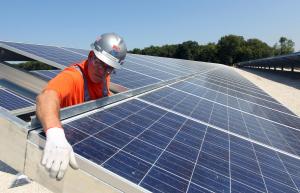When a former “senior communications official at the White House” writes a blog post for U.S. News and World Report, you should be able to trust it. But when the author states that the Keystone pipeline would create only 19 weeks of temporary jobs, everything else he says must be suspect—including the claim that our “energy infrastructure will be 100 percent solar by 2030.”
Both a union representative and one from TransCanada—the company behind the Keystone pipeline—affirmed that the 19-week timeframe was total fantasy. The portion of the Keystone pipeline that remains to be built is 1179 miles long. Construction should take two years.
The premise of the blog post is that we shouldn’t look at Keystone as a jobs creator. Instead, the author claims, the jobs are in “solar energy disruption.” He is frustrated that “GOP leaders almost universally ignore or disdain this emerging energy economy.”
He states: “A third of all new electric generation in 2014 came from solar.”
This may be true but, as you’ll see, it belies several important details. Plenty of cause exists for Republican lawmakers to “disdain” the growth in renewable energy.
First, efficient and effective coal-fueled electricity that has provided the bulk of America’s power is being prematurely shut down by regulations promulgated by the Obama administration. It is virtually impossible to get a new coal-fueled power plant permitted in the U.S. Even natural gas-powered plants meet with resistance. And, of course, just try to build a nuclear power plant and all the fear-mongers come out.
What’s left? Renewables, such as wind and solar, receive favorable treatment through a combination of mandates and subsidies.
The brand new report, Solar Power in the U.S. (SPUS), presents a comprehensive look at the impacts of solar power on the nation’s consumers.
We’ve seen companies, such as Solyndra, Abound Solar, and Evergreen Solar, go bankrupt even with millions of dollars in state and federal (taxpayer) assistance. I’ve written extensively on these stories and that of Abengoa—which received the largest federal loan guarantee ($2.8 billion) and has resorted to questionable business practices to keep the doors open.
SPUS shows that without the subsidies and mandates these renewable projects would do dark. For example, in Australia, sales of solar systems “fell as soon as the incentives were cut back.” Since the Australian government announced that it was reconsidering its Renewable Energy Targets “investments have started to dry up.”
Knowing the importance of the “incentives,” the solar industry has now become a major campaign donor, providing political pressure and money to candidates, who will bring on more mandates, subsidies, and tax credits. Those candidates are generally Democrats. The GOP doesn’t “disdain” solar, but they know it only survives because of government mandates that require a certain percentage of renewables, and specifically solar, in the energy mix, plus the subsidies and tax credits that make it attractive. Therefore, they can’t get excited about the jobs being created as a result of taxpayers’ involuntary investment, nor higher energy costs.
The blog post compares the “solar energy disruption” to what “occurred when DirecTV and Dish started to compete with cable television. More choices emerged and a whole lot of new jobs were created.” However, those jobs were created through private investment and the free market—a fact that, along with solar’s dependence on incentives, he never mentions.
SPUS draws upon the example of Germany, which has led the way globally in renewables. Over time the campaign has contributed to residential electricity prices more than doubling. Renewables receive favored status, called “priority dispatch,” which means that, when renewable electricity becomes available, the utilities must dispatch it first, thereby changing the merit order for thermal plants. Now, many modern power plants couldn’t operate profitably and, as a result, some were shut down, while others were provided “capacity payments” in order to stay online as back-up—maintaining system stability. In Germany’s push for 80 percent renewable energy by 2050, it has found that despite the high penetration of renewables, given their inherent intermittency, a large amount of redundancy of coal- and natural-gas-fueled electricity (nuclear being decommissioned) is necessary to maintain the reliability of the grid.
As the German experience makes clear, without a major technological breakthrough to store electricity generated through solar systems, “100 percent solar by 2030” is just one more fantasy.
The blog post ends with this: “the GOP congressional leadership ignores these new jobs … in favor of a vanishingly small number of mythical Keystone ‘jobs’ that may never materialize. It makes you wonder. Why?”
The answers can be found in SPUS, which addresses the policy, regulatory, and consumer protection issues that have manifested themselves through the rapid rise of solar power. It concludes: “Solar is an important part of our energy future, but there must be forethought, taking into account future costs, jobs, energy reliability and the overall energy infrastructure already in place. This technology must come online with the needs of the taxpayer, consumer and ratepayer in mind instead of giving the solar industry priority.”
The author of Energy Freedom, Marita Noon serves as the executive director for Energy Makes America Great Inc. and the companion educational organization, the Citizens’ Alliance for Responsible Energy (CARE). She hosts a weekly radio program: America’s Voice for Energy—which expands on the content of her weekly column.

COMMENTS
Please let us know if you're having issues with commenting.